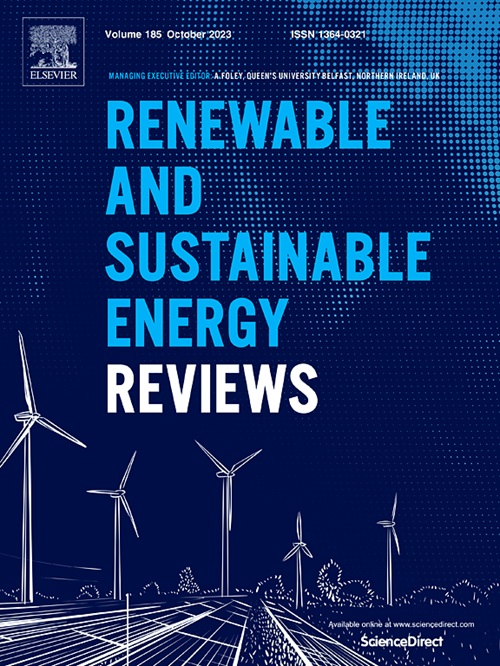基于有效集合协方差矩阵自适应进化算法的波风混合场址功率输出增强
IF 16.3
1区 工程技术
Q1 ENERGY & FUELS
引用次数: 0
摘要
浮式混合风波系统将海上风力平台和WECs结合在一起,创造出经济高效、可靠的能源解决方案。在有效地从波浪中提取能量的同时,需要适当设计和调整的WECs以避免可能干扰涡轮机运动的不必要负载。该系统使能源来源多样化,增强了能源安全,降低了供应风险,同时通过最大限度地减少能源生产的可变性,提供更平稳的电力输出。然而,这些系统的优化受到物理和流体动力组件-组件相互作用的阻碍,这导致了一个具有挑战性的优化空间。为了探索这种协同效应,本文考虑了一个5mw的OC4-DeepCwind半潜式平台和三个球形WECs。为了解决这些挑战,我们提出了一种有效的集成优化(EEA)技术,该技术结合了协方差矩阵自适应、新颖性搜索和离散化技术。为了评估EEA的性能,我们使用了位于澳大利亚南部海岸的四个海洋站点。在这个框架中,几何形状和功率输出(PTO)参数同时优化,以最大限度地提高混合风波系统的平均功率输出。集成优化方法通过识别给定问题的最佳算法或算法组合来增强性能、灵活性和鲁棒性,解决诸如过早收敛、停滞和搜索空间探索不良等问题。EEA与14种先进的优化方法进行了基准测试,证明了卓越的解决方案质量和收敛速度。与鲸鱼优化算法(WOA)、均衡优化算法(EO)和人工蜂鸟算法(AHA)相比,EEA的总功率输出分别提高了111%、95%和52%。此外,与集成正弦微分协方差矩阵自适应(LSHADE)、自适应微分进化(SaNSDE)和社会学习粒子群优化(SLPSO)等先进方法相比,EEA在悉尼海域的吸收功率增强了498%、638%和349%,显示了其在优化混合能源系统方面的有效性。本文章由计算机程序翻译,如有差异,请以英文原文为准。
Hybrid wave–wind energy site power output augmentation using effective ensemble covariance matrix adaptation evolutionary algorithm
Floating hybrid wind–wave systems combine offshore wind platforms and WECs to create cost-effective, reliable energy solutions. WECs that are properly designed and tuned are required to avoid unwanted loads that can interfere with turbine motion while efficiently extracting energy from waves. The systems diversify energy sources, enhance energy security, and reduce supply risks while delivering a smoother power output through the minimisation of energy production variability. However, optimisation of these systems is hindered by physical and hydrodynamic component–component interactions, which cause a challenging optimisation space. A 5-MW OC4-DeepCwind semi-submersible platform and three spherical WECs are taken into consideration in this paper in order to explore such synergies.
To address these challenges, we propose an effective ensemble optimisation (EEA) technique that combines covariance matrix adaptation, novelty search, and discretisation techniques. To evaluate the EEA performance, we used four sea sites located along Australia’s southern coast. In this framework, geometry and power take-off (PTO) parameters are simultaneously optimised to maximise the average power output of the hybrid wind–wave system. Ensemble optimisation methods enhance performance, flexibility, and robustness by identifying the best algorithm or combination of algorithms for a given problem, addressing issues like premature convergence, stagnation, and poor search space exploration. The EEA was benchmarked against 14 advanced optimisation methods, demonstrating superior solution quality and convergence rates. EEA improved total power output by 111%, 95%, and 52% compared to Whale Optimisation Algorithm (WOA), Equilibrium Optimiser (EO), and Artificial Hummingbird Algorithm (AHA), respectively. Additionally, in comparisons with advanced methods, Ensemble Sinusoidal Differential Covariance Matrix Adaptation (LSHADE), Self-adaptive Differential Evolution (SaNSDE), and Social Learning Particle Swarm Optimisation (SLPSO), EEA achieved absorbed power enhancements of 498%, 638%, and 349% at the Sydney sea site, showcasing its effectiveness in optimising hybrid energy systems.
求助全文
通过发布文献求助,成功后即可免费获取论文全文。
去求助
来源期刊

Renewable and Sustainable Energy Reviews
工程技术-能源与燃料
CiteScore
31.20
自引率
5.70%
发文量
1055
审稿时长
62 days
期刊介绍:
The mission of Renewable and Sustainable Energy Reviews is to disseminate the most compelling and pertinent critical insights in renewable and sustainable energy, fostering collaboration among the research community, private sector, and policy and decision makers. The journal aims to exchange challenges, solutions, innovative concepts, and technologies, contributing to sustainable development, the transition to a low-carbon future, and the attainment of emissions targets outlined by the United Nations Framework Convention on Climate Change.
Renewable and Sustainable Energy Reviews publishes a diverse range of content, including review papers, original research, case studies, and analyses of new technologies, all featuring a substantial review component such as critique, comparison, or analysis. Introducing a distinctive paper type, Expert Insights, the journal presents commissioned mini-reviews authored by field leaders, addressing topics of significant interest. Case studies undergo consideration only if they showcase the work's applicability to other regions or contribute valuable insights to the broader field of renewable and sustainable energy. Notably, a bibliographic or literature review lacking critical analysis is deemed unsuitable for publication.
 求助内容:
求助内容: 应助结果提醒方式:
应助结果提醒方式:


